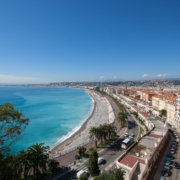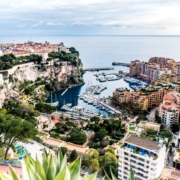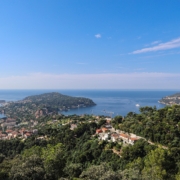Avignon often hides between the lines: not on postcards, but behind them – in shady alleys, on the facades of houses, on signs with the names of long-forgotten professions. The local streets do not open up like Roman squares or flirt like Parisian boulevards — but they quickly become familiar, like the backdrop of a favorite film. If you enjoy walking, discovering local shops, and getting lost among bakeries, this city is for you.
» READ MORE – A selection of sights in Avignon
We have prepared an audio guide to the city for you to bring it all to life, and there is also a discount on all audio guides with the promo code PARIS10.
Streets for walking
Avignon is full of antiquities, but the most fascinating details are found on the signs. Some streets still bear the names of medieval professions: Carpenters, Locksmiths, Butchers, Stables. Everything is clear without explanation – once upon a time, people really did carpentry, forged metal, roasted meat, and repaired harnesses here.
It’s easy to walk an extra block here simply because it’s so beautiful. We’ve chosen streets where it is especially pleasant to stray from the route.
Rue de la République
Avignon welcomes guests with a grand, straight, wide, and elegant street. It was cut through the medieval walls in the second half of the 19th century to connect the railway station with the central square. The project was approved by Napoleon III and implemented by Mayor Pamar – a name not well known today, but one that left a significant mark on the city.
Everything here looks like a postcard: facades with stucco details, cafés with terraces, waiters balancing trays, tourists with suitcases. This is the street of first impressions – a little noisy, a little pretentious, but undeniably charming.
In July, it changes character completely: actors, street performers, and even pianos on wheels appear right on the pavement – the festival takes over every meter. The rest of the year, it’s simply a main urban artery where you can watch Avignon at its most everyday.
Rue des Lices
Spacious and unusually straight for the old center, Rue des Lices runs along the southern edge of the historic district. The city walls once ended here, which gives it a feeling of being at the very edge.
Sometimes you catch sounds drifting from neighboring streets – the ringing of trams, the hum of the market, distant voices. But Rue des Lices itself feels detached: the facades have almost no shop windows, there are few signs, and greenery lines the pavements. At one end, you can glimpse the slope leading up to the Roches-de-Dom gardens, and at the other, a line of trees stretches into the distance along a cobbled path.
Locals walk here for short, practical routes: to buy bread, walk their dogs, or reach the next turn. It’s not a street people seek out, but one they stumble upon. Nothing much happens here – and that is precisely its quiet appeal.
Rue des Teinturiers
This is the only street in Avignon where the industrial past feels like an art installation. Once, fabric was rinsed and dyed here, then hung to dry above the water. Today, there’s only the shade of trees, the creaking of old wood, and the occasional splash.
The first thing you notice is the sound of water. Not a river, but a narrow canal, stubborn and winding like a country road. Massive wooden water wheels still turn in it: there used to be 23, but now only 4 remain. Dyers once worked here, and the street was purely industrial. Today, it has transformed into one of the most popular places for strolling.
In summer, performances take place right on the street – a couple of theaters set up open-air stages. The rest of the time, it’s peaceful, with just a few tourists and students passing by with coffee cups.
Cafés with terraces line the canal, and carved benches along the way spark the imagination – some see mythical creatures in them, others just remnants of old folklore. In the evening, soft lighting comes on. Water, old walls, blurred lights – Rue des Teinturiers becomes a perfect setting for photos. It’s one of the city’s most photogenic spots, yet it never feels overly decorative.
Rue Saint-Agricol
This street reveals itself gradually. It’s narrow and slightly crooked, as if built without a plan. Because of the bends, you never quite see what’s ahead — just a fragment of wall, a doorway, a flash of light, a passerby. It invites you to walk to the very end, just to find out where it leads.
At the end stands the Church of Saint Agricol. It’s not the one tourists usually read about in guidebooks – this is where locals come to light candles or sit quietly in the cool shade. The building blends into its surroundings, its Gothic portal hidden between plain facades. You could walk past without realizing it’s there, but you can feel its presence.
The street itself is peaceful, even though the busy center hums all around. All attention seems drawn inward – to the archway, the open door, the worn stone.
Squares where you linger
For some, these are just points on a map. But for travelers, they’re stages where everyday life unfolds. These are the places where you want to sit and simply watch the day go by – order a coffee, sip a glass of wine, and stay a little longer.
Place de l’Horloge
This square stands on the site of a Roman forum. Later, it became the location of the «Magnum Macellum» – a bustling medieval meat market.
In the 14th century, Cardinal Oden Ober built a tower chapel here, complete with wooden jack-in-the-box figures. Jacquemart and Jacotte still strike the hour today, just as they did in the 15th century. In the 19th century, two civic monuments were added: the Town Hall, consecrated by President Louis-Napoleon Bonaparte, and the Opera House, built in Italian style with columns, sweeping staircases, and ambitious design.
At the center stands a Belle Époque carousel with wooden horses. It isn’t just decoration – it’s part of local life. Around it, people drink coffee, debate, take photos, and pause to catch their breath.
Place des Carmes
Quiet and almost village-like, this square comes alive on Saturdays. From eight in the morning until one in the afternoon, a vibrant city market fills the space between Place des Carmes and Place Carnot. There’s fruit, vegetables, flowers, handmade goods, meat, and spices – not a single stall left empty.
» READ MORE – Where to Go Besides Paris? 10 Capitals of France
The rest of the week, the square is calm. There’s shade beneath the canopy, low conversations in cafés, someone carrying a baguette, someone else discussing the news. It’s the perfect place to pause and feel like a local, even if only for a moment.
Place Pie
In the morning, the Les Halles covered market bursts into life – noisy and fragrant with basil, cheese, and the latest gossip. The stalls overflow with seasonal produce from local farmers, and the vendors talk quickly, but always with a smile.
The market’s facade is decorated with a «green mural» – a living vertical garden created by master Patrick Blanc. It rustles softly in the wind and changes with the seasons, as if breathing in rhythm with the city.
Around the edges of the square, cafés nestle under the plane trees, and the 13th-century Tour Saint-Jean stands as a reminder that this is not just a market square, but a place of history and depth.
Place Crillon
Visit in the evening, when the air is warm, the voices gentle, and menus are read slowly. Guests leave the nearby Hôtel d’Europe at an unhurried pace, taking in their surroundings.
The Hôtel d'Europe is one of France’s oldest operating hotels, established in 1799. Bonaparte himself once stayed here. A little farther away, you’ll see the facade of the city’s first theater. The building has changed purposes over the centuries, but its distinctive features remain, standing as silent witnesses to countless performances and gatherings.
Place des Corps Saints
Beneath this square once lay a monastic necropolis where Celestine monks and high-ranking citizens were buried. In the 14th century, a monastery of the Celestine Order, founded by decree of Pope Clement VI, stood here. Its physical remains have long been hidden underground, but the memory survives in the square’s name: «Corps des Saints» (Bodies of the Saints), a reference to the burials, relics, and sacredness of the site.
At the center today stands a fountain by sculptor Jules Lavigne, cast in the renowned Val d’Osne foundry. Its classical design features delicate moldings, caryatids, and a decorative dome, giving it an almost theatrical elegance while maintaining a sense of solemnity. It adds height and balance to the space, reminding visitors that the city has not forgotten what this ground once was.
Avignon is so much more than just this list. But if you explore these places, you’ll likely find yourself wanting to return again and again.






 Sobolev Maksim / Unsplash
Sobolev Maksim / Unsplash 

 yaoqi / unsplash
yaoqi / unsplash  Jp Valery / Unsplash
Jp Valery / Unsplash  Hugues de BUYER-MIMEURE / Unsplash
Hugues de BUYER-MIMEURE / Unsplash Simon Berger / Unsplash
Simon Berger / Unsplash
Leave a Reply
Want to join the discussion?Feel free to contribute!